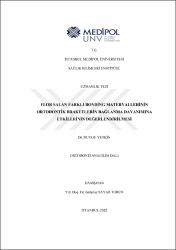| dc.contributor.advisor | Sayar Torun, Gülşilay | |
| dc.contributor.author | Yetkin, Duygu | |
| dc.date.accessioned | 2021-09-28T08:11:04Z | |
| dc.date.available | 2021-09-28T08:11:04Z | |
| dc.date.issued | 2016 | en_US |
| dc.date.submitted | 2016-10-31 | |
| dc.identifier.citation | Yetkin, D. (2016). Flor salan farklı bonding materyallerinin ortodontik braketlerin bağlanma dayanımına etkilerinin değerlendirilmesi. (Yayınlanmamış uzmanlık tezi). İstanbul Medipol Üniversitesi Diş Hekimliği Fakültesi, İstanbul. | en_US |
| dc.identifier.uri | https://hdl.handle.net/20.500.12511/8315 | |
| dc.description.abstract | Bu çalışmanın amacı flor salan üç farklı bonding ajanının metal braketlerin tutuculuğuna etkisinin geleneksel bir yapıştırıcı sistem ile karşılaştırmalı olarak incelenmesidir. Çalışmamızda 84 adet çekilmiş insan küçük azı dişi kullanılmış, çekilen dişler her grupta 21 diş olacak şekilde dört gruba ayrılmış ve braketler yapıştırılmıştır. Grup 1 Transbond XT (3M/Unitek), Grup 2 Clearfil SE Protect Bond (Kuraray Medical Inc.), Grup 3 L.E.D Proseal (Ultradent) ve Grup 4 Opalseal (Reliance Orthodontic Products Inc.) kullanılarak yapıştırılmış, braketlerin yapıştırılmasını takiben dişler 1000 devir termal döngüye tabi tutulmuştur. Sonrasında tüm dişlere sıyırma testi uygulanmış ve mine yüzeylerinde ARI skorlaması yapılmıştır. İstatiksel değerlendirmede, sıyırma testlerinde gruplar arasındaki farklılıkların belirlenmesi amacıyla One Way ANOVA Testi, ARI skorlarının karşılaştırılmasında ise Ki-kare testi ve Fisher kesin Ki-kare testi kullanılmıştır. Çalışmamızın sonuçlarına göre gruplar arasında bağlanma dayanımları açısından istatiksel olarak anlamlı fark bulunamamıştır. ARI skorlarında istatiksel olarak anlamlı fark bulunmuştur. Çalışmamızın sonucunda kullanılan tüm bonding materyallerinin klinik olarak yeterli bağlanma kuvveti gösterdiği tespit edilmiştir. | en_US |
| dc.description.abstract | The aim of this study is to compare the shear bond strength of three different fluoride-releasing bonding agents with a conventional adhesive system. In our study, 84 extracted human premolar teeth were used, the teeth were seperated into four groups consisting of 21 teeth in each group and brackets were bonded. Brackets were bonded with Transbond XT (3M/Unitek) in Group 1, with Clearfil SE Protect Bond (Kuraray Medical Inc.) in Group 2, with L.E.D Proseal (Ultradent) in Group 3 and with Opalseal (Reliance Orthodontic Products Inc.) in Group 4. After bonding the brackets the teeth were thermocycled 1000 times. Then, shear bond strength test was applied to each tooth and ARI scores of enamel were recorded. One Way ANOVA Test was used to compare shear bond strengths of all groups. Chi Square and Fisher's Exact Test were used to compare ARI scores. According to our results, no statistically significant difference was found between the shear bond strengths of the groups. The results of ARI scores were statistically significant. All bonding materials used in our study showed clinically adequate bond strengths. | en_US |
| dc.language.iso | tur | en_US |
| dc.publisher | İstanbul Medipol Üniversitesi Diş Hekimliği Fakültesi | en_US |
| dc.rights | info:eu-repo/semantics/openAccess | en_US |
| dc.subject | ARI | en_US |
| dc.subject | Bağlanma Dayanımı | en_US |
| dc.subject | Bonding | en_US |
| dc.subject | Flor | en_US |
| dc.subject | Ortodontik Braket | en_US |
| dc.subject | ARI | en_US |
| dc.subject | Bonding | en_US |
| dc.subject | Fluor | en_US |
| dc.subject | Orthodontic Brackets | en_US |
| dc.subject | Shear Bond Strength | en_US |
| dc.title | Flor salan farklı bonding materyallerinin ortodontik braketlerin bağlanma dayanımına etkilerinin değerlendirilmesi | en_US |
| dc.title.alternative | Evaluation of shear bond strength of different fluoride releasing bonding materials | en_US |
| dc.type | specialtyThesis | en_US |
| dc.department | İstanbul Medipol Üniversitesi, Diş Hekimliği Fakültesi, Ortodonti Ana Bilim Dalı | en_US |
| dc.relation.publicationcategory | Tez | en_US |


















